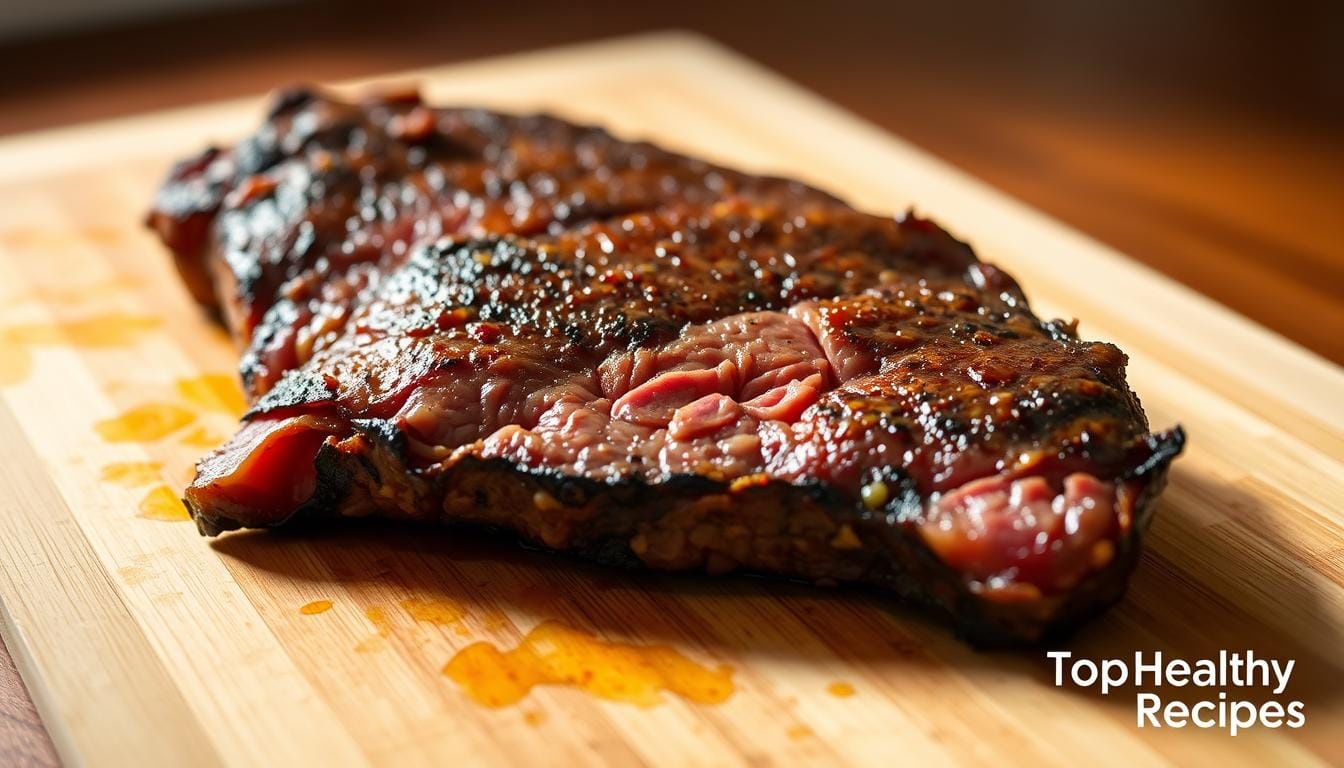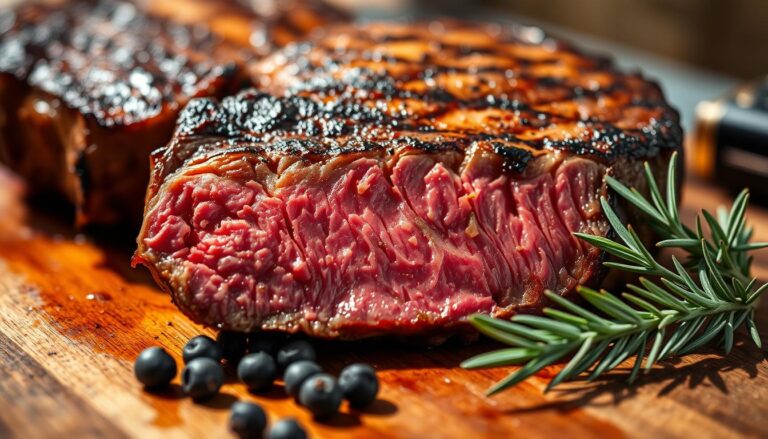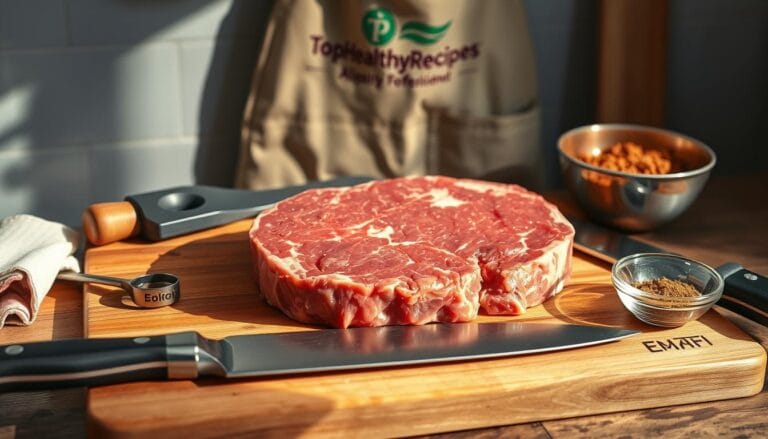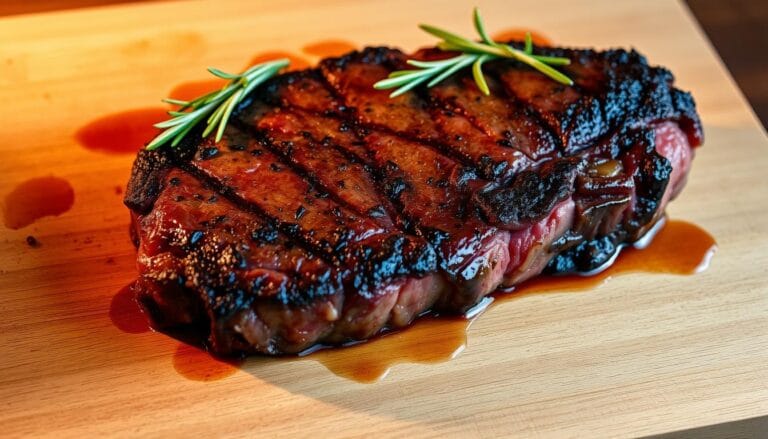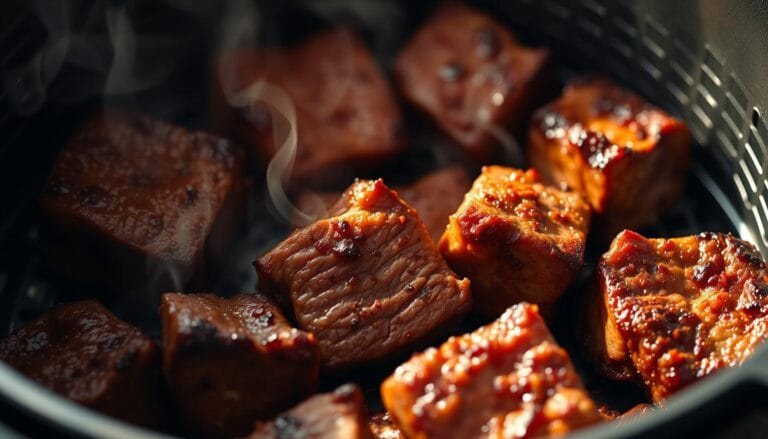Skirt Steak Internal Temp Guide: Perfect Doneness Every Single Time
Table of Contents
Skirt Steak Internal Temp Guide: Perfect Doneness Every Single Time
Getting the perfect doneness for skirt steak can seem tough. But, with the right tips, you can nail it.
Cooking skirt steak to the right internal temperature is key for a tasty dish. It doesn’t matter if you’re new to cooking or have lots of experience. Knowing how to control the temperature will make you a better cook.
By using a detailed guide on internal temp, you can make steak that’s as good as what you get in restaurants. You’ll get perfect doneness every time you cook.
Key Takeaways
- Understand the ideal internal temperature for skirt steak
- Learn cooking methods to achieve perfect doneness
- Discover expert tips for cooking skirt steak
- Master the art of cooking restaurant-quality skirt steak at home
- Achieve consistent results with every cook
Understanding Skirt Steak
Skirt steak comes from the cow’s diaphragm area. It’s famous for its distinctive grain pattern and deep flavor. This cut is great at soaking up marinades and stays tender when cooked right.
What is Skirt Steak?
Skirt steak is from the cow’s diaphragm. It’s known for its rich flavor and unique texture. There are two main types: inside and outside skirt steak.
The inside cut is softer and more even in thickness. This makes it easier to cook. The outside cut, though, has a stronger taste but needs careful cooking to be tender.
Common Cuts and Their Uses
The inside skirt steak is loved for its tenderness. It’s often used in fajitas and stir-fries.
The outside skirt steak has a deeper flavor but can be tougher. It’s best for marinated grilled dishes. Butchers prepare these cuts to bring out their best qualities for cooking.
The Importance of Internal Temperature
The internal temperature of skirt steak is key to its texture, juiciness, and taste. It’s important to know how temperature affects the meat for the best results.
Why Internal Temp Matters
Internal temperature is key because it affects the meat’s texture and safety. Cooking skirt steak to the right temperature makes it tender and safe. Protein denaturation happens when meat heats up, changing its texture and juiciness.
Because skirt steak is thin, controlling temperature is even more important. Understanding how proteins change at different temperatures helps cook skirt steak perfectly.
Effects of Undercooking and Overcooking
Undercooking skirt steak can be unsafe because of harmful bacteria. Overcooking makes the meat tough and dry, losing flavor. Finding the right balance is key for perfect doneness.
| Cooking Method | Internal Temperature | Result |
|---|---|---|
| Undercooked | Below 125°F | Potential food safety issues, underdeveloped flavors |
| Perfectly Cooked | 125°F – 135°F | Tender, juicy, and flavorful |
| Overcooked | Above 160°F | Tough, dry meat with diminished flavor |
Knowing the effects of undercooking and overcooking is vital for perfect doneness. By checking the internal temperature, you can ensure your skirt steak is just right.
Recommended Internal Temperatures
The secret to a perfect skirt steak is knowing the right internal temperatures. These temperatures help you achieve the perfect doneness. This is key for tenderness and flavor.
Rare: 125°F
Cooking to 125°F makes the steak very red and cool inside. It’s perfect for those who love their steak rare. It’s super tender.
Medium Rare: 135°F
For a medium-rare skirt steak, aim for 135°F. This temperature is ideal for most recipes. It gives a warm red center with great juiciness and flavor.
Medium: 145°F
At 145°F, the steak has a warm pink center. It’s slightly less moist than medium-rare but has more flavor.
Well Done: 160°F
Cooking to 160°F makes the steak fully cooked with no pink. But, it’s not the best choice for skirt steak. It can get tough.
| Doneness Level | Internal Temperature | Description |
|---|---|---|
| Rare | 125°F | Very red, cool center |
| Medium Rare | 135°F | Warm red center, optimal juiciness and flavor |
| Medium | 145°F | Warm pink center, more developed flavors |
| Well Done | 160°F | No pink, fully rendered fat |
Medium-rare is often the best choice for skirt steak. It balances tenderness with flavor. Also, take the steak off the heat 5-10°F before your target. This is because of carryover cooking.
Tools for Measuring Temperature
Getting the internal temperature right is key to perfect skirt steak. You’ll need a reliable thermometer to cook your steak just right.
Meat Thermometers Explained
A meat thermometer is essential for any serious griller or cook. It lets you check the steak’s internal temperature. This ensures it’s cooked safely and to your liking. There are many types of thermometers, each with its own benefits and drawbacks.
Types of Thermometers include instant-read digital, wireless smart, thermocouple, and traditional dial thermometers. Each has its own special features:
- Instant-read digital thermometers give quick results, perfect for thin cuts like skirt steak.
- Wireless smart thermometers let you monitor your steak’s temperature from another room.
- Thermocouple thermometers are the fastest and most accurate, loved by pros.
- Traditional dial thermometers are cheaper but slower than digital ones.
| Thermometer Type | Accuracy | Speed | Price Range |
|---|---|---|---|
| Instant-read Digital | High | Fast | $10-$50 |
| Wireless Smart | High | Fast | $50-$100 |
| Thermocouple | Very High | Very Fast | $20-$100 |
| Traditional Dial | Medium | Slow | $5-$20 |
When picking a thermometer, think about your cooking style and budget. It’s also important to insert it correctly, which is easier with thin cuts like skirt steak. Make sure your thermometer is calibrated for accurate readings.
Getting a good thermometer is a key step to cooking skirt steak perfectly. Knowing about the different thermometers and how to use them will help you cook great skirt steak every time.
Preparing Skirt Steak
To get the perfect skirt steak, start with top-notch meat. The prep involves several steps. These steps make sure your steak tastes great and is cooked just right.
Choosing Quality Meat
When picking skirt steak, look for good marbling. This makes the steak tender and tasty. The USDA grading system helps find the best meat. USDA Prime and USDA Choice are top choices for their quality and marbling.
Check the meat’s color and freshness. Fresh skirt steak should be a vibrant red. Stay away from meat that’s too brown or smells bad. These signs mean the meat is old or not handled well.
| USDA Grade | Description | Marbling |
|---|---|---|
| USDA Prime | Highest quality, tender, and flavorful | Abundant |
| USDA Choice | High quality, less marbling than Prime | Moderate |
| USDA Select | Leaner, less tender than Choice | Less |
Marinating Tips
Marinating is key for skirt steak. It makes the steak tender and flavorful. A good marinade has acidic parts like citrus or vinegar to soften the meat.
Marinate the steak for 2 to 24 hours for the best results. The longer it marinates, the better it tastes. Use a glass or ceramic container to avoid metal reacting with the acid.
A great marinade also has oil to carry flavors and garlic and herbs for extra taste. These add to the steak’s natural flavor.
Cooking Methods for Skirt Steak
There are several ways to cook skirt steak to the perfect temperature. Each method has its own benefits. Knowing these can help you choose the best way to cook your steak.
Grill or Broil
Grilling or broiling uses high heat to quickly sear the steak. It also lets you control the inside temperature well. To grill, set up your grill with both hot and cool zones. This helps sear the steak first and then cook it more gently.
It’s important to manage flare-ups when grilling skirt steak. This is because it’s a thin cut.
Pan-Searing
Pan-searing is great for home cooks. It lets you make a tasty crust on the steak. You can also keep an eye on the steak’s temperature.
Use a hot skillet with a bit of oil for a good sear. Then, adjust the heat to cook the steak to your liking.
Sous Vide
Sous vide cooking is all about precise temperature control. It cooks the steak in water to the exact temperature you want. Then, you quickly sear it to add flavor.
This method ensures the steak is cooked evenly. It also helps avoid overcooking.
| Cooking Method | Advantages | Considerations |
|---|---|---|
| Grill or Broil | Quick sear, caramelized exterior | Risk of flare-ups, requires grill setup |
| Pan-Searing | Excellent control, flavorful crust | Requires attention to heat adjustment |
| Sous Vide | Precise temperature control, consistent results | Requires sous vide equipment, additional searing step |
Each cooking method has its own benefits. The best choice depends on your equipment, experience, and what you like. By mastering these methods, you can always cook skirt steak perfectly.
Cooking Times Based on Thickness
The thickness of your skirt steak is key to cooking it right. Skirt steak can be anywhere from ½ to 1 inch thick. This thickness affects how long it needs to cook.
Thickness and Cooking Time Guidelines
To cook skirt steak well, adjust the cooking time based on its thickness. Here’s a guide to help you get it just right:
| Thickness | Cooking Method | Cooking Time per Side | Internal Temperature |
|---|---|---|---|
| ½ inch | Grilling/Broiling | 2-3 minutes | 130°F – 135°F |
| ¾ inch | Pan-Searing | 3-4 minutes | 135°F – 140°F |
| 1 inch | Sous Vide | 1-2 hours | 130°F – 135°F |
If your skirt steaks are uneven, try butterflying the thicker parts. Or, place the steak so the thicker parts are closest to the heat.
Adjusting for Different Cooking Methods
Each cooking method needs its own timing. For grilling or broiling, cook for 2-3 minutes per side for medium-rare. Pan-searing takes a bit longer, about 3-4 minutes per side. Sous vide cooking takes longer, about 1-2 hours, but it’s more forgiving.
Knowing how thickness, cooking method, and time work together is essential. By adjusting your cooking based on these factors, you’ll always get perfect skirt steak.
Letting Your Steak Rest
The final step in cooking your skirt steak is not actually cooking it, but letting it rest after reaching the right internal temperature. Resting is a key step to achieve perfect doneness. When you remove your steak from the heat, its internal temperature will rise due to residual heat, known as carryover cooking.
Benefits of Resting
Resting your skirt steak has several benefits. It allows the juices to redistribute, making the meat tender and flavorful. It also lets the meat reabsorb juices that were pushed to the surface during cooking. This makes the steak more evenly cooked and moist.
- Temperature Redistribution: The heat from the exterior moves towards the cooler interior.
- Moisture Reabsorption: The steak reabsorbs juices, making it more tender and flavorful.
- Carryover Cooking: The internal temperature continues to rise, ensuring the steak is cooked to your liking.
How Long to Rest
For skirt steak, a resting period of 5-7 minutes is usually enough. This time allows for the best juice redistribution and carryover cooking. To keep the steak warm, tent it loosely with aluminum foil. This method keeps the heat in and prevents steam from softening the crust.
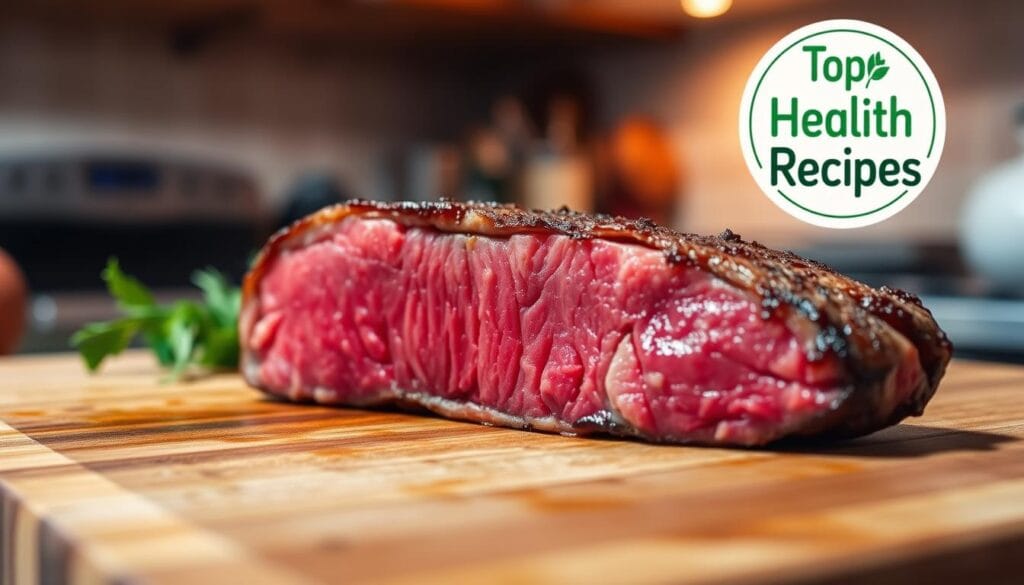
Understanding the importance of resting your skirt steak and using the right techniques can make your steak reach its full flavor and tenderness. This ensures a better dining experience.
Serving Suggestions
Now that your skirt steak is perfectly cooked, let’s talk about how to serve it. The right sides and sauces can make your meal even better. They bring out the rich, beefy taste you’ve worked so hard to get.
Pairing with Sides
Choosing sides for skirt steak is simple. Try roasted potatoes or crusty bread. These options let the meat take center stage.
Vegetables like grilled asparagus or roasted peppers also work well. For something fresh, a simple green salad with a light dressing is perfect.
Ideal Sauces
Sauces can really elevate your skirt steak. Chimichurri sauce is a great choice. It adds a tangy touch that balances the meat’s richness.
For a Mexican twist, serve with warm tortillas, lime juice, and pico de gallo. These add flavor and make the meal more enjoyable.
Tips for Achieving Perfect Doneness
Getting perfect doneness with skirt steak is easier than you think. It all comes down to controlling the temperature and using the right cooking methods.
Common Mistakes to Avoid
One big mistake is putting the thermometer in the wrong spot. Skirt steak is thin, so put the thermometer horizontally in the thickest part. Also, make sure the steak is at room temperature before cooking. This helps it cook evenly.
Timing is key because skirt steak cooks fast. Keep a close eye on it to avoid overcooking. A thermometer that stays in the steak is very helpful.
Checking Temperature During Cooking
Checking the temperature is essential to get the steak just right. Because skirt steak is irregularly shaped, check it in different spots. You can also use your sense of touch and sight to check doneness. A rare steak feels soft, while a well-done steak is firm.
Tempering your meat before cooking and using a thermometer correctly are key. Also, know how your cooking method affects the steak’s temperature. For example, grilling can quickly increase the steak’s internal temperature.
By avoiding common mistakes and learning to check temperature, you’ll get perfect doneness every time.
Flavor Enhancements
To take your skirt steak to the next level, think beyond just the right internal temperature. The right seasoning can enhance the steak’s natural taste without overwhelming it.
Spice Blends for Skirt Steak
Simple salt and pepper are great for letting the beef’s flavor stand out. For a Latin twist, try cumin, chili, and oregano. These are perfect for fajitas and carne asada.
For an Asian flair, use marinades with soy, ginger, and garlic. These add depth and enhance the steak’s natural taste.
Adding Aromatics
Different seasonings react differently to heat and cooking time. Some spices can handle high heat without burning, while others need more care.
A culinary expert says, “The key to maximizing flavor is to balance the seasoning with the cooking method.” Salt is important because it helps keep moisture in during cooking.
Adding compound butters or fresh herbs after cooking can add a burst of flavor. They perfectly complement the steak.
Storage and Reheating
To enjoy your skirt steak beyond the initial meal, it’s key to know how to store and reheat it. Proper handling keeps your skirt steak safe and of high quality.
Proper Storage Techniques
Cool your cooked skirt steak fast to stop bacteria from growing. Once it’s cooled, wrap it tightly in plastic wrap or aluminum foil. This stops oxidation, which can cause bad flavors and textures.
You can store it in the fridge for up to 3-4 days. For longer storage, freezing is a good option. Freezing works best if you slice the steak before wrapping it, making it easier to thaw only what you need.
- Cool the steak quickly to a safe temperature.
- Wrap it tightly to prevent air exposure.
- Refrigerate for up to 3-4 days or freeze for longer storage.
Best Reheating Methods
Reheating your skirt steak without overcooking it needs a gentle touch. Briefly exposing it to low heat or using a sous vide machine works well. These methods keep the steak’s original doneness and internal temperature.
Reheating Tips:
- Use low heat to prevent overcooking.
- Sous vide reheating maintains precise temperature control.
- Consider slicing the steak cold for salads or sandwiches as an alternative to reheating.
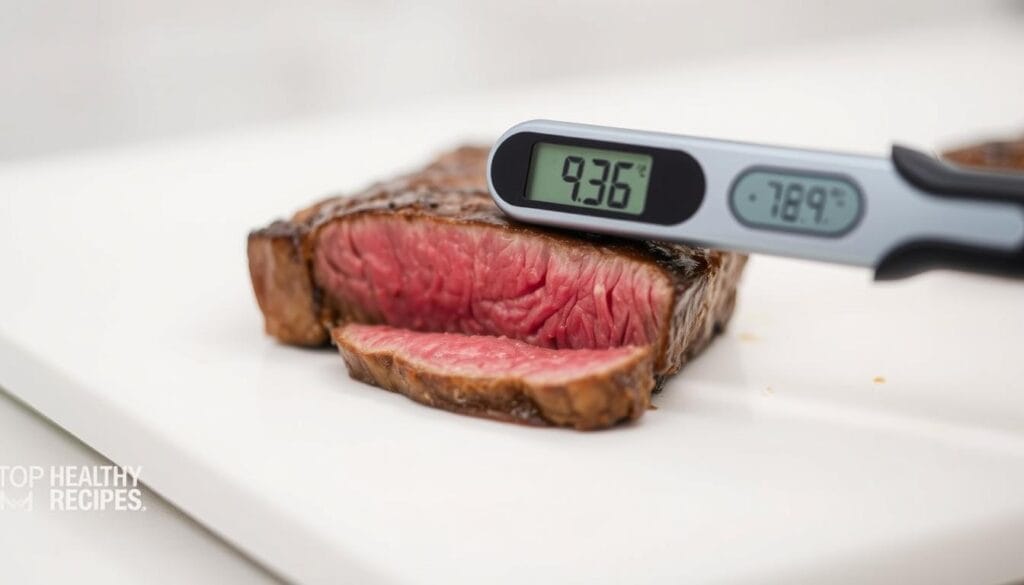
Skirt Steak vs. Other Cuts
When looking at steak options, knowing the differences between skirt steak and other cuts is key. Skirt steak is often compared to flank steak. But these cuts have unique traits that change how they cook and the techniques used.
Comparison to Flank Steak
Flank steak and skirt steak are both favorites for their taste and texture. But they are different in important ways. Flank steak comes from the cow’s belly, is leaner, and has a uniform thickness.
Skirt steak, from the diaphragm area, has a richer taste and is often more tender when cooked right.
| Characteristics | Skirt Steak | Flank Steak |
|---|---|---|
| Origin | Diaphragm area | Belly of the cow |
| Flavor | Richer, beefier | Leaner, slightly less intense |
| Tenderness | More tender when cooked right | Can be tougher if overcooked |
Price and Availability
Skirt steak’s popularity has made it pricier and harder to find. It’s more expensive than flank steak because of its rich flavor and tender texture. But prices can change based on where you are, the quality, and how easy it is to find.
Market Considerations:
- Skirt steak is often more expensive due to its popularity and the demand for its flavor profile.
- Flank steak is generally more accessible and can be a more budget-friendly alternative.
- Regional variations in butchering and labeling can affect the availability of these cuts.
Knowing these differences helps you make better choices and adjust your cooking methods. Whether you pick skirt steak or flank steak, getting the internal temperature right is essential for a great meal.
Nutritional Information
## Nutritional Information
Understanding skirt steak’s nutritional profile helps you make better diet choices. It’s a food rich in protein and essential nutrients.
### Protein and Fat Content
Skirt steak has about 26g of protein in a 4oz serving. The fat content varies with trimming and cooking methods. A 4oz serving usually has around 10g of fat, but you can trim it to reduce fat.
### Health Benefits of Skirt Steak
Skirt steak is not just high in protein but also in iron, zinc, and B vitamins, like B12. These nutrients are key for energy, nerve function, and making red blood cells. Adding skirt steak to your diet can boost your health, as long as it’s part of a balanced diet.
Here are some key nutritional benefits of skirt steak:
- High protein content for muscle maintenance and growth
- Rich in iron, helping prevent anemia
- Good source of zinc, supporting immune function
- Contains B vitamins, essential for energy production
- Supports a balanced diet when consumed in moderation
When cooking skirt steak, the temperature impacts nutrient retention. Cooking it to the right temperature ensures you get the most nutritional benefits while enjoying your steak.
Frequently Asked Questions
Many people ask about cooking skirt steak to perfection. Let’s look at some common questions and give expert answers. This will help you get better at cooking skirt steak.
Common Queries About Skirt Steak
People often ask about the difference between inside and outside skirt steak. Inside skirt steak is from the diaphragm area and is more tender. It has a delicate flavor. Outside skirt steak is from the plate section and is slightly tougher. But it’s full of flavor too.
There are many ways to cook skirt steak, like grilling, pan-searing, or sous vide. Knowing the right internal temperature is key.
Expert Answers to Your Questions
One question is if skirt steak can be safely eaten rare. For skirt steak, cooking to 125°F – 130°F is safe. This is if you handle and store it properly.
Another question is about skirt steak being tough, even when cooked right. This usually happens when you slice against the grain. Slicing against the grain makes the steak tender by shortening muscle fibers.
| Cooking Method | Internal Temperature | Result |
|---|---|---|
| Grilling | 130°F – 135°F | Medium Rare |
| Pan-Seering | 135°F – 140°F | Medium |
| Sous Vide | 125°F – 130°F | Rare |
For thin or thick skirt steaks, cooking time matters. Thin cuts cook fast and can get overcooked. Thick cuts need more time to reach the right temperature.
Knowing about skirt steak cooking, like internal temperature and slicing, will help you cook it perfectly every time.
Conclusion
Now you know how to cook skirt steak perfectly. The key is to control the internal temperature of your steak.
Key Takeaways
The right internal temperatures for skirt steak are: 125°F for rare, 135°F for medium-rare, 145°F for medium, and 160°F for well-done. A meat thermometer is essential. It helps ensure your steak is safe to eat and stays tender and flavorful.
Experimenting with Temperature
As you get better at cooking skirt steak, try different temperatures. Start with medium-rare (135°F) and adjust as you like. With time, you’ll get great at cooking skirt steak just right.
Follow these tips and watch your skirt steak internal temp closely. You’ll soon be a pro at making delicious skirt steak dishes that everyone will love.
FAQ
What is the ideal internal temperature for cooking skirt steak?
What is skirt steak, and how does it differ from other cuts?
How do I cook skirt steak to achieve the perfect internal temperature?
Can skirt steak be safely eaten rare?
Why did my skirt steak turn out tough despite reaching the right temperature?
How do I adjust cooking for an extremely thin or thick skirt steak?
What’s the difference between inside and outside skirt steak?
How do I store and reheat cooked skirt steak?
What are some recommended seasonings and marinades for skirt steak?
For more cooking tips, stay connected with us. We also recommend the cookbook Skinnytaste Simple: Easy, Healthy Recipes with 7 Ingredients or Fewer
For more Recipes about Steak ?
Did You try our recipe ?
There are no reviews yet. Be the first one to write one.
